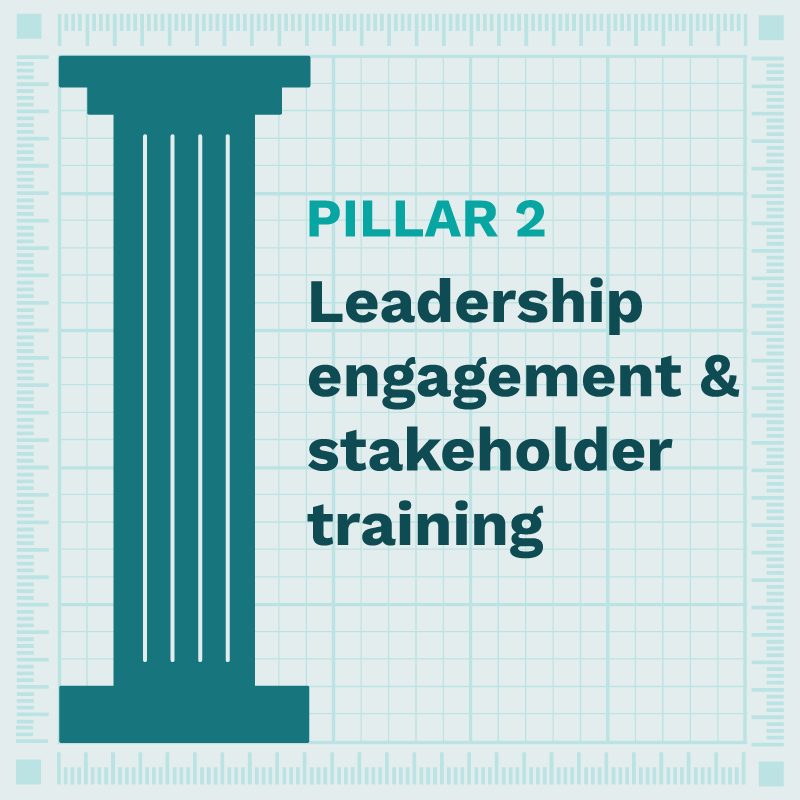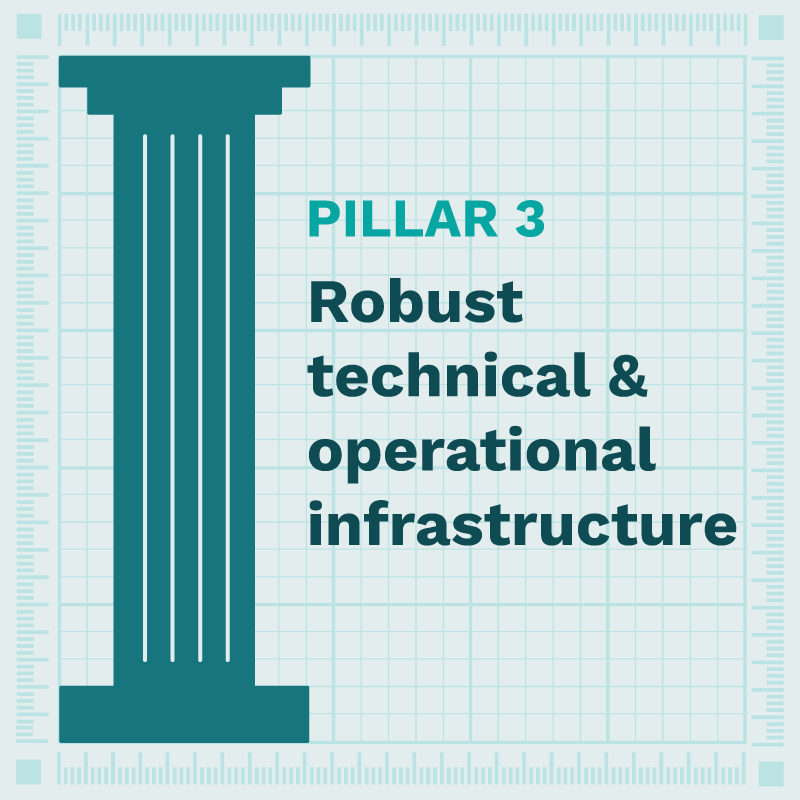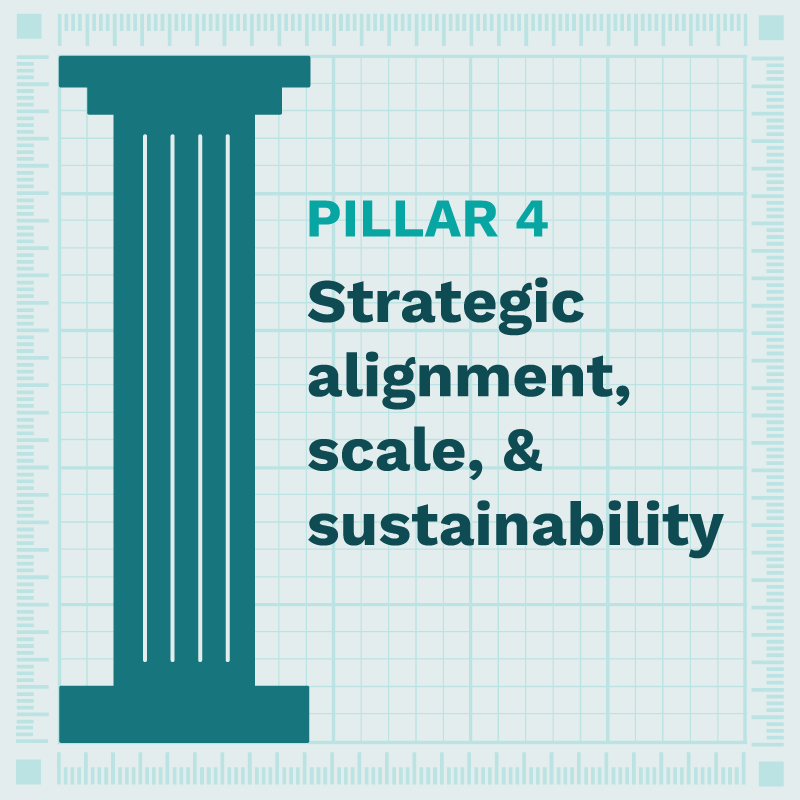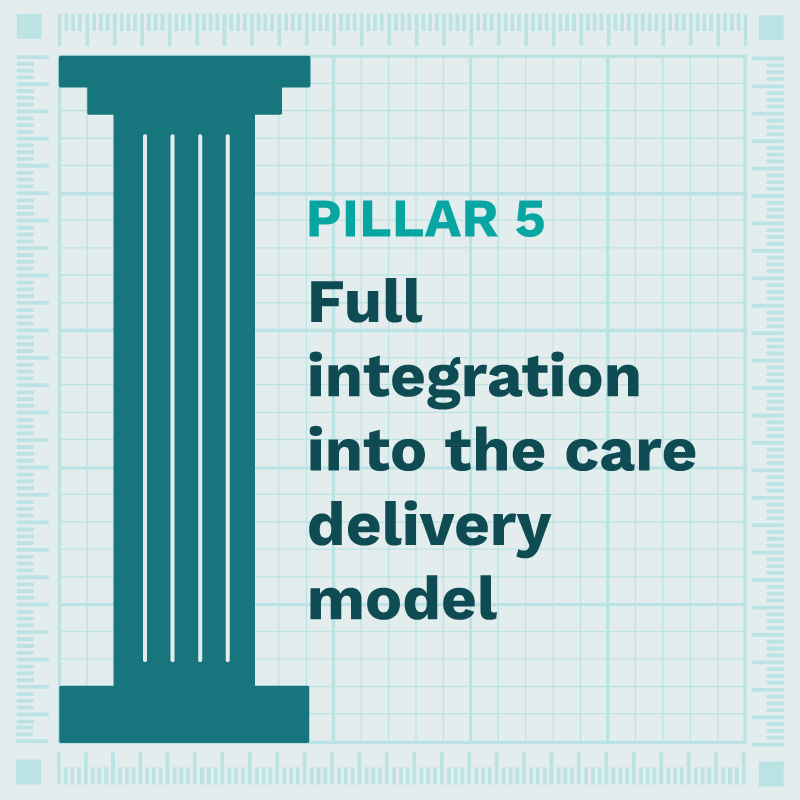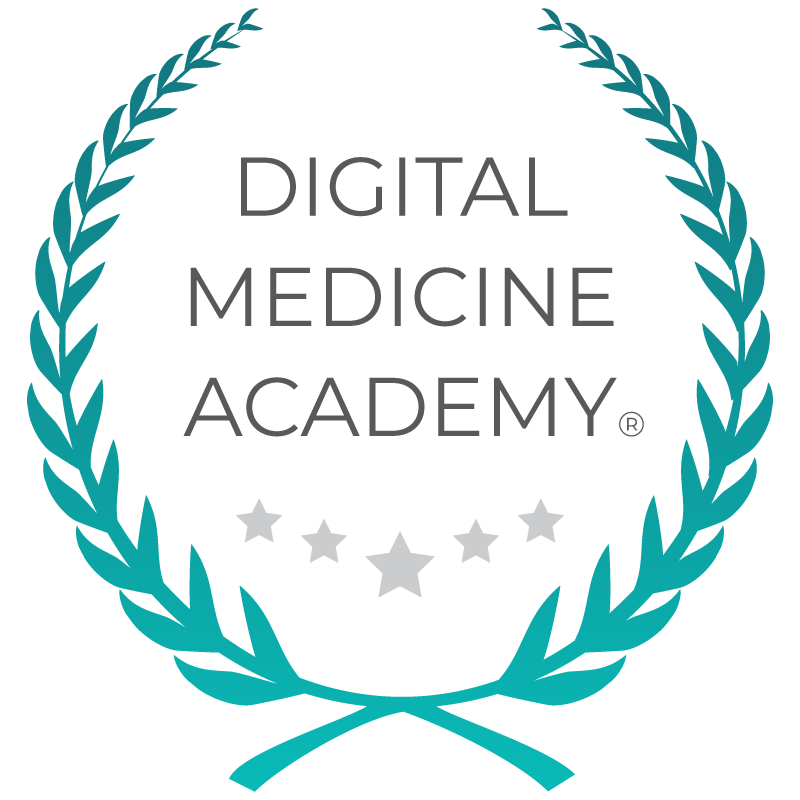DIME PROJECT

Building healthcare around the patient, not the clinic

THE BLUEPRINT | SECTION 4
Pillars of successful implementation
Successful hospital-at-home (HaH) programs are built on a robust foundation designed to meet the unique demands of delivering acute care in the home setting. Use these five pillars to navigate implementation challenges, foster crucial stakeholder alignment, and deliver high-quality, integrated, and sustainable care that patients can trust.
Pillar 1: Patient safety & experience
At the heart of every HaH program is the patient. Ensuring high-quality, safe, and person-centered care presents unique challenges when acute services shift to the home, yet it is critical for patients to feel as secure, heard, and well-cared-for as they would in a traditional hospital setting.
Achieving this demands intentional collaboration, from regulators establishing clear safety standards, to hospitals ensuring robust patient support, and DHT developers building intuitive, accessible technology. By collectively championing patient safety and experience, each stakeholder leverages their expertise toward this shared goal, positioning HaH to successfully advance care and become a trusted, preferred option for all.
WHAT GOOD LOOKS LIKE
When done well, HaH care makes patients feel safe, seen, and supported—without needing an extended stay in a hospital facility.
See how this works in practice with ChristianaCare’s Hospital Care at Home program.
Refer back to Section 1: Patient Journey Map to see how safety and experience are woven throughout HaH from the patient and care partner perspective.
-
 Patients and care partners receive care tailored to their needs in their place of choice.
Patients and care partners receive care tailored to their needs in their place of choice. -
 Health systems and providers gain capacity, reduce costs, and improve outcomes.
Health systems and providers gain capacity, reduce costs, and improve outcomes. -
 DHT developers see the benefits of their tools utilized more broadly and effectively.
DHT developers see the benefits of their tools utilized more broadly and effectively. -
 Payors, regulators, and policymakers see a viable, equitable care model.
Payors, regulators, and policymakers see a viable, equitable care model.
Pillar 2: Leadership engagement & stakeholder training
Successful HAH implementation requires cultural and clinical transformation, necessitating a workforce that is competent and confident in decentralized settings. Therefore, engaged leadership is essential for driving this transformation, securing frontline buy-in, establishing clear roles, and ensuring the model is fully owned. Comprehensive training is equally vital, providing staff with the specific skills and confidence needed to deliver HaH safely and effectively, especially when leveraging technology and managing care in the home.
By investing heavily in active leadership engagement and comprehensive workforce training, stakeholders collectively champion the successful adoption and sustainment of HaH, embedding it into acute care delivery across diverse settings and solidifying its transformative role in healthcare.
WHAT GOOD LOOKS LIKE
Empowered teams and engaged leaders are the backbone of any successful HaH program, ensuring safe, coordinated care beyond hospital walls.
See how this comes to life through Mayo Clinic’s Hospital-at-Home model.
Refer back to Section 3: Program evaluation & reimbursement pathways to explore how workforce readiness and leadership alignment contribute to program success.
-
 Health system leaders see successful adoption and sustainability driven by capable, engaged teams who not only implement the model but also embrace it.
Health system leaders see successful adoption and sustainability driven by capable, engaged teams who not only implement the model but also embrace it. -
 Payors, regulators, and policymakers gain confidence in HaH’s value and growth potential with a well-prepared workforce.
Payors, regulators, and policymakers gain confidence in HaH’s value and growth potential with a well-prepared workforce. -
 DHT developers see innovations effectively leveraged by trained staff.
DHT developers see innovations effectively leveraged by trained staff. -
 Patients and care partners benefit directly from safe, seamless care.
Patients and care partners benefit directly from safe, seamless care.
Effective cross-functional HaH leadership teams include:
- Executive sponsors for strategic alignment and budget authority.
- Clinical leaders for protocol development and safety oversight.
- Operational leaders for workflow integration and staffing.
- Technology leads for remote monitoring, telehealth, and EHR integration.
- Finance and compliance experts for billing, contracts, and documentation.
- Patient and care partner advocates for shared decision-making.
Pillar 3: Robust technical & operational infrastructure
Delivering acute care in the home setting requires a robust technical infrastructure and a well-designed operational framework for everything from remote monitoring and communication to supply chain management and documentation. Without this robust foundation, the HaH model cannot achieve the reliability and efficiency needed for safe, consistent care at home.
Success demands focused investment in robust infrastructure and close ecosystem collaboration to develop interoperable technologies that enable seamless function and efficient workflows. By prioritizing this pillar, stakeholders enable HaH to fulfill its promise of high-quality home-based care and position the model for successful advancement.
WHAT GOOD LOOKS LIKE
Robust, interoperable infrastructure is the backbone of safe and scalable HaH care.
See how IPS is helping define the future of connected, patient-centered home care through their support of a comprehensive HaH deployment.
Refer back to the Section 2: Technical & operational considerations for a detailed breakdown of infrastructure requirements and real-world workflows.
-
 Health systems and providers need these reliable systems for effective care delivery.
Health systems and providers need these reliable systems for effective care delivery. -
 DHT developers play a crucial role in innovating and integrating interoperable solutions, which they would then see successfully scale.
DHT developers play a crucial role in innovating and integrating interoperable solutions, which they would then see successfully scale. -
 Payors and policymakers require assurance that these systems enable measurable, scalable outcomes without compromising safety.
Payors and policymakers require assurance that these systems enable measurable, scalable outcomes without compromising safety. -
 Patients and care partners rely on this robust infrastructure for consistent, accessible, and safe care that feels comparable to that of a hospital.
Patients and care partners rely on this robust infrastructure for consistent, accessible, and safe care that feels comparable to that of a hospital.
Pillar 4: Strategic alignment, scale, & sustainability
Unlike traditional care delivery, scaling HaH requires strategic endorsement as a permanent option within the large-scale acute care landscape rather than remaining a temporary alternative. Achieving widespread adoption and long-term sustainability is essential not only for delivering continuous value and improving population outcomes through reduced utilization, but also for establishing HaH as a reliable, accessible option that patients and care partners can truly depend on.
Championing this scale demands deliberate action: policymakers must enable sustainable reimbursement, systems must align HaH with enterprise strategy, and the ecosystem must collaborate on innovative models and technologies that drive measurable growth and integration. By uniting behind scale and sustainability, stakeholders leverage their collective expertise to position HaH as an indispensable, permanent component advancing the future of acute care delivery.
WHAT GOOD LOOKS LIKE
Scaling HaH isn’t about standing up a pilot—it’s about embedding a future-ready model into the health system’s long-term strategy.
UMass Memorial Health demonstrates this through a sustained commitment to at-home care, anchored by a digital hub and enterprise-wide alignment.
Refer back to Section 3: Program evaluation & reimbursement pathways to learn how to demonstrate value, measure outcomes, and ensure long-term viability.
-
 Health systems secure capacity and improved margins by integrating HaH into core operations.
Health systems secure capacity and improved margins by integrating HaH into core operations. -
 Payors and policymakers realize sustainable value through lower costs.
Payors and policymakers realize sustainable value through lower costs. -
 DHT developers gain scalable deployment pathways for their innovations.
DHT developers gain scalable deployment pathways for their innovations. -
 Patients and care partners have a dependable acute care choice at home, where they prefer to be.
Patients and care partners have a dependable acute care choice at home, where they prefer to be.
Pillar 5: Full integration into the care delivery model
Achieving full integration requires intentional effort from health systems to embed HaH into clinical pathways, staffing, and EHRs, coupled with collaborative development of interoperable technologies by partners across the ecosystem to break down silos and align processes. By collectively championing full integration, stakeholders ensure HaH becomes a standard, indispensable component of the care delivery model, creating a truly seamless and patient-centered healthcare system that extends beyond traditional walls.
WHAT GOOD LOOKS LIKE
When HaH is fully integrated, it functions as a true extension of the hospital—embedded into staffing, workflows, and clinical decision-making.
See how UMass Memorial Health built a deeply coordinated model using a centralized digital hub and cross-functional care teams.
-
 Health systems achieve operational efficiency and enhanced patient flow through the integration of embedded pathways and systems.
Health systems achieve operational efficiency and enhanced patient flow through the integration of embedded pathways and systems. -
 Patients and care partners experience safer, more coordinated care.
Patients and care partners experience safer, more coordinated care. -
 Payors and policymakers can better evaluate outcomes across the continuum.
Payors and policymakers can better evaluate outcomes across the continuum. -
 DHT developers see their innovations embedded into core workflows.
DHT developers see their innovations embedded into core workflows.

